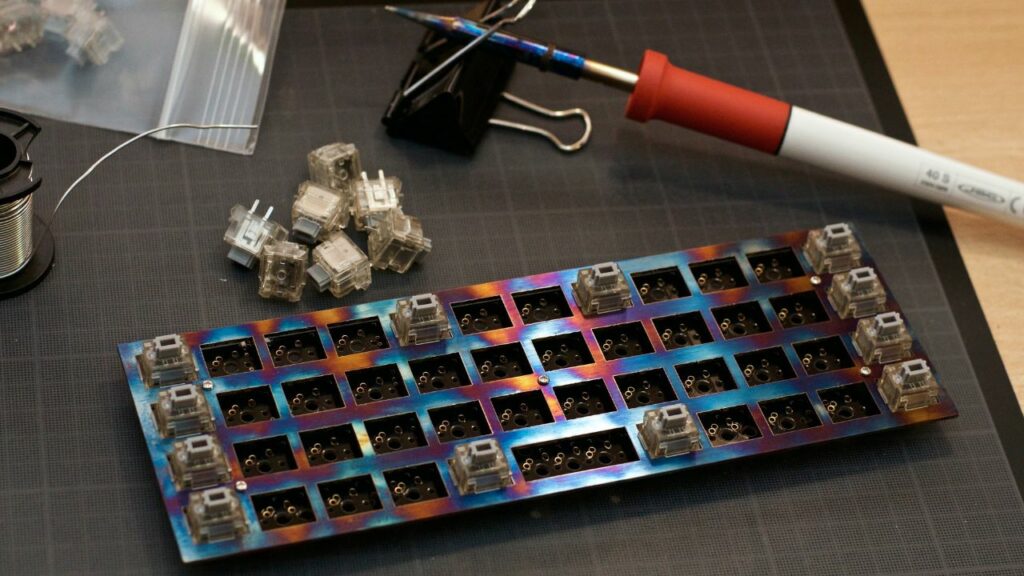
When you dive into the world of gaming keyboards, you’ll notice there’s more than meets the eye. Take, for instance, the decision between plate mount and PCB mounted switches. Both have their unique features and benefits, and understanding them can help you decide what’s best for your gaming experience.
Plate Mount Switches: Stability and Protection
Plate mount switches are the bigger brothers in this duo. Because of their size, they’re generally easier to replace if need be. The term ‘plate mount’ comes from the fact that they’re installed on a mounting plate, typically made of metal like aluminum or brass. This process involves some additional hardware such as screws and nuts, but don’t let this intimidate you – it’s all part of ensuring your keyboard is robust and ready to handle any gaming marathon.
The plate adds an extra layer of protection against shock and vibration, which is always handy when things get intense during game night! Another advantage is the feel they provide; plate-mounted switches add more rigidity and support than their PCB counterparts. This heavier feel often appeals to gamers using larger keyboards that require more structure.
PCB Mounted Switches: Simplicity and Affordability
On the other hand, PCB mounted switches offer a simpler approach. These little guys are designed to be soldered directly onto a printed circuit board (PCB). No extra hardware needed here! They might be small, but don’t underestimate them – with proper design and manufacture, they can have just as long a life expectancy as plate-mounted switches.
A unique feature of PCB-mounted switches is their 5-pin design. When you take a peek at their underside, you’ll find two metal pins (the heart of the switch), two plastic pins for stability, and a middle “pin” that resembles a large circular knob. This design allows them to be cost-effective since no additional reinforcement plate is required.
But what happens if you prefer these switches but have a plate mount keyboard? Well, there’s good news – with some careful clipping of those extra pins on the bottom, your PCB switch will fit just fine!
The Best of Both Worlds
Interestingly enough, there are ways to enjoy benefits from both types of switches! For example, hot swappable PCBs can support either 5 pin or 3 pin switches but always use plate mounting because they lack sufficient stabilization without it.
If you’re someone who loves to explore beyond the conventional, you might find yourself drawn to materials other than aluminum or brass for your keyboard plates. Have you considered options like polycarbonate or carbon fiber? They offer a unique touch and could be just what you’re looking for.
When it comes to picking the right keyboard for your needs – be it programming or just casual gaming – the choice between 3-pin and 5-pin designs can be a bit daunting. But don’t worry, we’ve got you covered with a variety of options to choose from.
Understanding the Pin Difference

One noticeable difference between these two types of switches is the number of pins they have. PCB-mounted switches come with 5 pins, while plate-mounted switches feature 3 pins. This might seem like a minor detail, but it’s actually quite fundamental in their design and use. The additional two plastic pins on PCB-mounted switches are there to provide stability, while plate-mounted switches rely on the plate itself for that extra steadiness.
The Installation Process
While both types of switches end up in your keyboard one way or another, their installation processes are a tad different. With plate-mounting, the switch is first installed onto a metal plate above the PCB, then soldered to the PCB. On the other hand, PCB mounting involves soldering the switch directly onto the PCB – no middleman involved here!
Customizability: Mix and Match
We’ve established that both types of switches can serve you well depending on your needs. But what if you want to experiment with different feels and sounds? Plate mounting offers a bit more flexibility here, as you can easily replace individual switches without having to de-solder them from the PCB.
Material Matters: Aluminum vs Brass Plates
The two most common materials for plates are aluminum and brass. These offer different feels due to their respective levels of rigidity. Aluminum plates tend to result in a lighter typing feel with a higher pitched sound when keys are pressed. In contrast, brass plates offer a stiffer typing experience, transmitting more force from your keystrokes into the keyboard and creating a lower pitched sound.
Frequently Asked Questions
Can I use PCB mounted switches on a plate mount keyboard?
Yes! You can modify a PCB mount switch to fit a plate mount by clipping off the extra plastic pins.
What’s better for gaming: Plate mount or PCB mounted switches?
Both types have their strengths! Plate mount switches offer better protection from shock and vibration due to their added rigidity while PCB mounted ones are simpler and more affordable.
What’s easier to install?
PCB mounted switches require less hardware for installation making them easier to install than plate mount ones.
Can I mix different kinds of switches on my keyboard?
If you’re using plate mounting, yes! You can replace individual switches easily without having to de-solder them from the PCB. Here’s a guide on some good keyboard switches this year.
The Final Verdict?
At the end of the day, deciding between plate mount or PCB mounted switches boils down to personal preference. Whether it’s the sturdy feel of plate mount switches under your fingertips or the flexibility offered by PCB mounted ones that appeals to you more – remember that both types bring something unique to your gaming experience.
So next time you’re pondering over which type of switch best suits your style – whether it’s for winning at Fortnite or coding Python scripts into the wee hours – take a moment to consider these factors. After all, every detail counts in creating an optimized gaming setup!